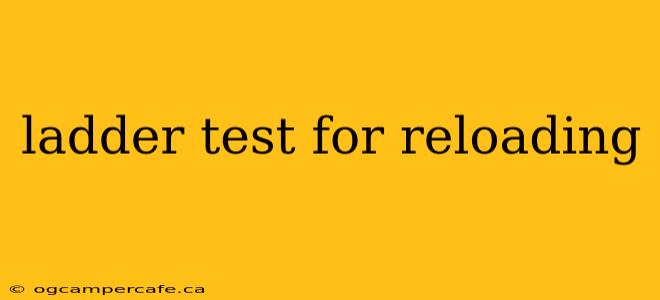Reloading your own ammunition can be a rewarding hobby, offering precision and cost savings unavailable with factory rounds. However, finding the optimal load for your firearm requires careful experimentation. The ladder test is a crucial method for this process, ensuring safety and maximizing performance. This guide provides a comprehensive overview of the ladder test for reloading, covering its methodology, safety precautions, and interpretation of results.
Understanding the Ladder Test
The ladder test is a systematic approach to determining the optimal powder charge for your specific firearm and bullet combination. It involves incrementally increasing the powder charge in a series of test rounds, allowing you to observe the effects on accuracy and pressure. This method helps you identify the "sweet spot"—the powder charge that provides the best balance between accuracy and pressure, staying safely below the maximum allowable pressure (MAP).
Key Benefits of the Ladder Test:
- Safety: It helps avoid exceeding the MAP, preventing dangerous pressure spikes and potential firearm damage.
- Accuracy Optimization: It identifies the powder charge that produces the tightest shot groups, improving your shooting accuracy.
- Consistency: It helps you find a consistent load that performs reliably, shot after shot.
- Data-Driven Approach: It provides measurable data for analyzing load performance, allowing for adjustments and further refinement.
Conducting a Safe and Effective Ladder Test
Before you begin, ensure you have a thorough understanding of reloading safety procedures. Improper handling of firearms and ammunition can lead to serious injury or death. Always consult your firearm's owner's manual and reloading manuals for specific recommendations.
Materials Required:
- Reloading Press: A reliable press suitable for your chosen cartridge.
- Dies: Appropriate sizing, powder measure, and seating dies for your cartridge.
- Powder Scale: An accurate powder scale to precisely measure powder charges.
- Cases: Clean, properly prepared cases for your chosen cartridge.
- Bullets: Bullets of the desired weight and type.
- Primers: Primers appropriate for your chosen cartridge.
- Chronograph: Highly recommended for measuring velocity and identifying potential pressure signs.
- Target: A suitable target for shooting at a safe distance.
- Notebook and Pen: To record all data meticulously.
Step-by-Step Procedure:
- Start Low: Begin with a minimum powder charge well below the maximum listed in your reloading manual. This is your starting point.
- Incremental Increases: Increase the powder charge incrementally in small, consistent steps (e.g., 0.2 grains) for each subsequent round. This forms your "ladder."
- Number of Rounds: Shoot at least five rounds at each charge weight. More is always better for accurate data collection.
- Consistent Variables: Maintain consistent bullet seating depth, case preparation, and other variables to ensure fair comparison between rounds.
- Record Data: Meticulously record the powder charge for each round and its corresponding position on the target. Note any unusual sounds or signs of excessive pressure. Chronograph readings are invaluable here.
- Analyze Results: After firing all rounds, analyze the target and chronograph data. Look for the tightest groups indicating optimal accuracy and consistent velocities.
Interpreting Results and Identifying the Optimal Load
The optimal load is typically identified by the powder charge that produces the smallest, most consistent group on the target. However, you must also consider velocity and pressure signs.
Pressure Signs: Look for flattened primers, excessive case expansion, or unusual sounds (like a sharp crack) during firing. These are indicators of excessive pressure and should be taken seriously. Never exceed the maximum listed pressure in your reloading manual. If you observe pressure signs, discontinue the test and reduce your powder charge.
Conclusion: Refining Your Reloading Technique
The ladder test is an essential tool for any serious reloader. It allows you to systematically optimize your powder charges, enhancing both accuracy and safety. Remember to prioritize safety and meticulous record-keeping throughout the process. By following these guidelines, you can refine your reloading technique and develop consistently accurate and reliable loads for your firearms. Remember always to consult reputable reloading manuals and seek guidance from experienced reloaders if you have any questions or concerns.
